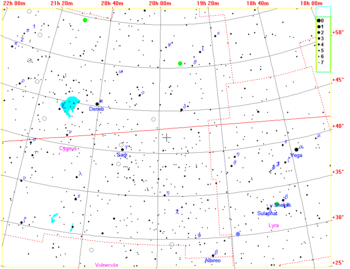HD 188753
|
Triple star HD 188753 |
||
|---|---|---|

|
||
| HD 188753 in the constellation Swan | ||
| Observation data epoch : J2000.0 |
||
| AladinLite | ||
| Constellation | swan | |
| Right ascension | 19 h 54 m 58.4 s | |
| declination | + 41 ° 52 ′ 18 ″ | |
|
Vis. Brightness (total) |
7.41 mag | |
| Astrometry | ||
| parallax | (22.3 ± 0.8) mas | |
| distance | (146 ± 5) ly ((44.8 ± 1.6) pc ) |
|
| Individual data | ||
| Names | A, B, C | |
| Observation data: | ||
|
Apparent brightness |
A. | 7.43 m |
| B. | m | |
| C. | m | |
| Typing: | ||
| Spectral class | A. | G |
| B. | K0 V | |
| C. | M. | |
| Astrometry: | ||
|
Absolute visual brightness M vis |
A. | 4.17 likes |
| B. | like | |
| C. | like | |
| Physical Properties: | ||
| Dimensions | A. | 1.06 M ☉ |
| B. | 0.8 M ☉ | |
| C. | 0.3 M ☉ | |
| radius | A. | 1.28 R ☉ |
| B. | R ☉ | |
| C. | R ☉ | |
| Luminosity | A. | 1.6 L ☉ |
| B. | L ☉ | |
| C. | L ☉ | |
| Effective temperature | A. | 5000-5900 K |
| B. | 3500-4850 K | |
| C. | 2000-3350 K | |
| Designations and catalog entries | ||
| Bonn diam. | BD + 41 ° 3535 | |
| HD catalog | HD 188753 | |
| SAO catalog | SAO 48968 | |
| Tycho catalog | TYC 3145-504-1 | |
| Hipparcos catalog | HIP 98001 | |
| ADS catalog | ADS 13125 | |
| Other names |
LTT 15826 | |
HD 188753 is a triple star system approximately 149 light years from Earth. It is in the constellation Swan . The main star is a yellow dwarf , which is orbited by a Jupiter-like planet (distance to A approx. 8 million km). The two companions are late main sequence stars. The two small stars orbit each other and also the main star. The orbit around the main star takes place at varying distances from 6 AU to 15 AU.
Origin problem
The most commonly used theory is that the planet (Ab) was created from the particles of matter that were left after the ignition of the nuclear fusion. The formation of the planet can only begin beyond the so-called "snow line". Because only there is the temperature so low that gases can freeze into ice particles. These ice particles then combine with dust particles and slowly increase in mass. The soon-to-be planet surrounds itself with an atmosphere due to further gases from the matter disk. The question now arises as to how the planet got so close to the star. It is believed that due to the gravity of the rest of the matter disk, the planet took a spiral path towards the star. However, there are some problems here. Actually, B and C should have disturbed the dust disc so much that it could not have expanded to the snow line. In addition, the presence of three stars should have heated the dust disc strongly, which would also have counteracted the formation of planets. In addition, the disk of matter should not have been large enough to allow the formation of a Jupiter-like planet. In addition, the three stars would have to have dissolved matter after a maximum of 25,000 years. However, the formation of such a planet takes much longer (approx. 1 million years). In order to solve the problem of planet formation in such an environment, it was theorized that the three-star system was earlier a four-star system with much larger distances. Tearing out one of these stars, for example by another passing star, could bring the remaining constellation closer together. However, the question still remains as to why the planet suddenly changed from its spiral movement towards the star to a stable orbit. It should also be noted that Jupiter and Saturn did not spiral towards the sun. However, research in this area is still at an early stage. It is not known exactly which physical and chemical processes play a role in such systems.
swell
- Eggenberger et al .: No evidence of a hot Jupiter around HD 188753 A ; in: Astronomy and Astrophysics, Vol. 466, No. 3, pp. 1179ff. (2007), bibcode : 2007A & A ... 466.1179E
- http://www.sueddeutsche.de/wissen/astrophysik-die-verbotene-welt-1.833470-3
- http://www.nasa.gov/vision/universe/newworlds/threesun-071305a.html